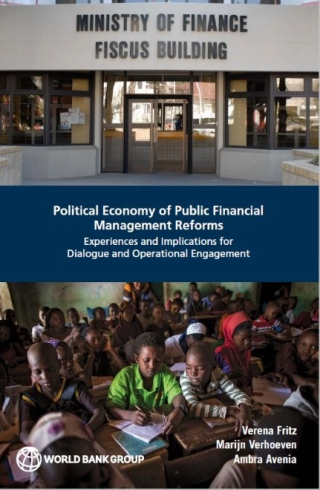
Posted by Benoit Taiclet[1]
A recent report published by the World Bank[2] takes stock of long lasting efforts to improve PFM systems. Since 2002, nearly 150 countries have undertaken at least one Public Expenditure and Financial Accountability (PEFA) assessment, and development partners have spent US$1.3 billion annually to support PFM reforms. However, there is a lack of studies which analyze the impact of this support on fiscal performance and budgeting, and why the impact has varied so widely across countries. The authors’ goal in this report is to close this gap, and explain what accounts for the variable rates of progress among different countries.
The report follows a twofold methodology. First, it maps out what PFM progress looks like across countries, regions, and income groups. Second, it drills down into specific experiences and issues of how PFM reforms have progressed, or struggled to take root. The first aspect, based on a quantitative analysis, covers mainly low- and middle-income countries. The second aspect seeks to understand in detail what PFM strengthening efforts were made in a small sample of countries (namely Georgia, Nepal, Nigeria, Philippines, and Tanzania).
An interesting and original feature of the report is its focus on the political economy of PFM reforms. The underlying idea is that reforms are seldom driven solely by a concern for their impact on development or equity but, more often, by concerns to give preferential treatment to certain individuals, elites, or groups within society. What is stated in the initial policy statements and action plans of the government is thus rarely what is delivered in the end.
Here are some key findings from the report:
- Should all PFM fundamentals be strengthened before “second-generation” reforms are considered? Improving basic elements of PFM is indeed critical, but also hard to achieve. The report concludes that keeping a focus on setting the basics is right, yet it is unrealistic to assume these steps will be completed before more advanced reforms are initiated.
- What is the preferred approach: big bang or incremental? While “transformational”—rapid and substantial—PFM strengthening is rare, slow and incremental improvements are common, albeit with risks that progress will slow down or be reversed. Ideally, reformers should seek and exploit “windows of opportunity” to kick start reforms, then during less-transformational periods, keep a deliberate focus on maintaining the reform agenda and counteracting the risk of backsliding.
- Are there friends and foes of PFM reforms? It is important to avoid an overly simple categorization of stakeholders into “reform proponents” and “reform opponents”. Most stakeholders have complex motivations and may support or oppose part of a reform initiative depending on their political agenda, interests, and affiliations. Yet stakeholders are generally wary about complex approaches that entail long planning phases, or face likely resistance.
- Institutional arrangements matter. Business models and functions in central finance agencies, the executive-legislative relationship, powers over fiscal policy and budget management, and intergovernmental arrangements including those for oversight and accountability, can either enable or pose significant obstacles to reform.
- See what can be done and how. Identifying key gaps at the outset of developing reform efforts can help develop a “problem-driven” approach based on some honest stock-taking of reform bottlenecks, and which instruments to utilize to close identified gaps.
- What about the use of international standards? Standards may help, or they may not. Setting international norms and encouraging their adoption is neither good nor bad per se, but their sponsors must consider the country’s needs. In this vein, the report flags a few unorthodox approaches[3] that have been successful, while contradicting conventional notions of “best practice”. Conversely, implementing international norms proves more helpful when dealing with issues that go against the grain of key national stakeholders—such as establishing an independent external audit institution. If international norms and standards are promoted, it is critical that national stakeholders have training opportunities to learn about these standards in depth.
- How should the government talk to the public? Many PFM reforms that are conducted without sufficient publicity have proved short-lived. Hence, there is a need to transmit information on reforms in plain language to broad groups of policy-makers, policy-influencers, citizens, and the media. These groups have the potential to incentivize political commitment to implement and sustain PFM reforms, and to increase their impact.
All in all, this report is a must read for government officials and those who advise them about reforming their PFM systems. When dealing with the challenge of strengthening PFM systems, decision-makers are often confronted with stark choices between several possible approaches such as “basics first versus smart reforms”, or “big bang versus incremental change”, or “a bottom-up versus top-down approach”. This report does not give a definite answer to these recurrent questions, nor provides a “one-size-fits-all” solution for all countries and all situations. Yet, it should help policy makers think through the options for designing and implementing reforms, while illuminating how political, institutional, and fiscal drivers intersect and interact.
[1] Benoit Taiclet is a Senior Economist in the Public Financial Management II Division of the IMF’s Fiscal Affairs Department.
[2] Verena Fritz, Marijn Verhoeven, and Ambra Avenia, 2017. Political Economy of Public Financial Management Reform: Experiences and Implications for Dialogue and Operational Engagement. (Washington DC: World Bank).
[3] Georgia offers an example of successful “unorthodox” approach that contradicts “best practice”. Instead of selecting a “customized off the shelf solution” IT package recommended by donors for treasury automatization, the government developed an in-house system which eventually proved viable and less costly.
Note: The posts on the IMF PFM Blog should not be reported as representing the views of the IMF. The views expressed are those of the authors and do not necessarily represent those of the IMF or IMF policy.



